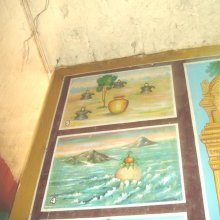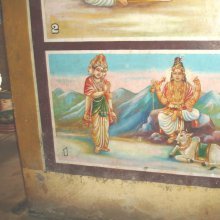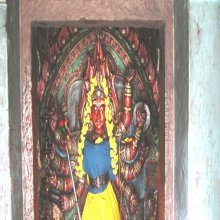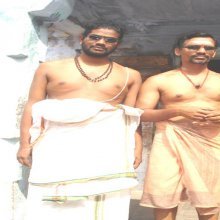Pralaya, Pralayā: 27 definitions
Introduction:
Pralaya means something in Hinduism, Sanskrit, Jainism, Prakrit, Marathi, Hindi. If you want to know the exact meaning, history, etymology or English translation of this term then check out the descriptions on this page. Add your comment or reference to a book if you want to contribute to this summary article.
Alternative spellings of this word include Pralay.
Images (photo gallery)
(+2 more images available)
In Hinduism
Shaivism (Shaiva philosophy)
Source: Wisdom Library: Kubjikāmata-tantraPralayā (प्रलया):—Fourth of the eight Mātṛs born from the body of Ātmī, according to the Kubjikāmata-tantra. These eight sub-manifestations (mātṛ), including Pralayā, symbolize the different kinds of souls, as well as the impurities by which these souls are bound (except for Niṣkala or Śiva). They are presided over by the Bhairava Caṇḍa and his consort Brāhmī. Ātmī is the second of the Eight Mahāmātṛs, residing within the Mātṛcakra (third of the five cakras) and represents the ātman.
Source: Google Books: Spanda Karikas (The Divine Creative Pulsation)Pralaya (प्रलय) refers to “disappearance of the world”, according to (commentaries on) the Spanda Kārikās section 1.—Both Rāmakaṇṭha and Utpala Bhaṭṭa warn that pralaya and udaya are not to be taken as corresponding to unmeṣa and nimeṣa exactly in the order in which they are given in the text but rather in a different order i.e. udaya with unmeṣa, and pralaya with nimeṣa:—“When there is unmeṣa i.e., aunmukhya or inclination towards manifestation, there is the udaya or emergence of the world. When there is nimeṣa or retraction of that inclination, there is submergence of the world”. Kṣemarāja takes pralaya and udaya both ways i.e. in a different order (bhinnakrama) as advocated by Rāmakaṇṭha and Utpalabhaṭṭa, and also in the order as they appear in the text. When taken in a different order, the meaning would be as given above. When taken in the order in which they appear in the text, the meaning would be as given below:—“When there is unmeṣa or revelation of the essential nature of the Divine, there is the pralaya or disappearance of the world. When there is nimeṣa or concealment of the essential nature of the Divine, there is the udaya or appearance of the world”. Both these interpretations are correct. In the first interpretation, the words unmeṣa and nimeṣa are construed with reference to Śakti of Śiva. In the second interpretation, they are construed with reference to the svarūpa or essential nature of Śiva.
Source: SOAS University of London: Protective Rites in the Netra TantraPralaya (प्रलय) refers to “dissolution”, according to the Netratantra of Kṣemarāja: a Śaiva text from the 9th century in which Śiva (Bhairava) teaches Pārvatī topics such as metaphysics, cosmology, and soteriology.—Accordingly, [verse 10.1-7ab, while describing the appearance and worship of Bhairava]—“[...] He] bears a sword and shield, holds a hook and noose. [His] hand[s and posed] in the wish fulfilling and protection [mudrās. He] holds the thunderbolt of a great hero. [He also] holds an axe and a hatchet. Having worshipped Bhairava, [the Mantrin] remembers being joined in union [with] him, [in the same way as] dissolution in fire (pralaya-agni-samākārā)”.

Shaiva (शैव, śaiva) or Shaivism (śaivism) represents a tradition of Hinduism worshiping Shiva as the supreme being. Closely related to Shaktism, Shaiva literature includes a range of scriptures, including Tantras, while the root of this tradition may be traced back to the ancient Vedas.
Natyashastra (theatrics and dramaturgy)
Source: Wisdom Library: Nāṭya-śāstraPralaya (प्रलय, “fainting”).—One of the eight ‘involutary states’ (sāttvikabhāva), according to the Nāṭyaśāstra chapter 7. These ‘involutary states’ are different from consequents (anubhāva) because of their arising from the inner nature (sattva). The term is used throughout nāṭyaśāstra literature. (Also see the Daśarūpa 4.6-7)
Source: archive.org: Natya ShastraPralaya (प्रलय, “fainting”) occurs due to too much toil, swoon, intoxication, sleep, injury, astonishment and the like. Loss of Consciousness should be represented by inaction, motionlessness, imperceptible breathing and [finally] by falling on the ground.

Natyashastra (नाट्यशास्त्र, nāṭyaśāstra) refers to both the ancient Indian tradition (shastra) of performing arts, (natya—theatrics, drama, dance, music), as well as the name of a Sanskrit work dealing with these subjects. It also teaches the rules for composing Dramatic plays (nataka), construction and performance of Theater, and Poetic works (kavya).
Purana and Itihasa (epic history)
Source: archive.org: Puranic EncyclopediaPralaya (प्रलय).—(Destruction). Pralaya is of four kinds. The first is nityapralaya. This is the destruction going on daily for all animate and inanimate objects born on earth. The second is Brāhmapralaya or naimittikapralaya. The third is Prākṛtapralaya. This is the great deluge made by prakṛti (nature) at the end of a thousand Caturyugas (four yugas). The fourth is ātyantikapralaya. This is the union of the soul with the Supreme Being due to Jñāna. Of the above the Brāhmapralaya, or naimittikapralaya happens at the end of a Kalpa or a day of Brahmā or a thousand yugas. The nature of this pralaya is as follows: At the end of a thousand yugas the world will look famished. Then there will be excessive drought for a hundred years together and everything in this world would be destroyed then. Then Mahāviṣṇu, lord of everything in this universe, would present himself in the seven big rays of the Sun and drink to emptiness all the waters of all the three worlds, earth, ocean and pātāla. Then by the divine power of Mahāviṣṇu the seven rays of the Sun which had grown fat by drinking this water would become seven separate Suns. These Suns would burn all the three worlds including Pātāla. Then the earth would look like the back of a tortoise (Kūrmapṛṣṭha) At that time Rudra, equal in brilliance to Kālāgni, would from beneath burn the pātāla sending breaths from Ādiśesa. After pātāla Kālāgnirudra would burn the earth and then the heavens. Because of this all the worlds would look like globes of fire. Then the inhabitants of these worlds would go to Maharloka unable to bear the heat and from there to Janaloka. Thus Viṣṇu in the form of Rudra would destroy everything. (See full article at Story of Pralaya from the Puranic encyclopaedia by Vettam Mani)
Source: Cologne Digital Sanskrit Dictionaries: The Purana IndexPralaya (प्रलय).—The deluge: destruction; after Manvantaras;1 two kinds—one at the end of a Kalpa or the day of Brahmā and the other at the end of the life of Brahmā.2
Source: Shodhganga: The saurapurana - a critical studyPralaya (प्रलय) refers to “creation or evolution of the Universe” and represents one of the various aspects of the Pañcalakṣaṇa definition of Purāṇas, according to Amarakoṣa: the famous Sanskrit lexicon of the 5th Century A.D.—Accordingly, the Purāṇas are supposed to contain theories about [viz., pratisarga (recreation of the universe after its periodic dissolution)].—In the Saurapurāṇa, pratisarga is also termed as pratisañcara and pralaya.

The Purana (पुराण, purāṇas) refers to Sanskrit literature preserving ancient India’s vast cultural history, including historical legends, religious ceremonies, various arts and sciences. The eighteen mahapuranas total over 400,000 shlokas (metrical couplets) and date to at least several centuries BCE.
Vaishnavism (Vaishava dharma)
Source: Pure Bhakti: Brhad BhagavatamrtamPralaya (प्रलय) refers to:—Annihilation of the universe; cosmic inundation; Śrīmad Bhāgavatam describes four kinds of annihilation: continuous, occasional, elemental and final. 1) Nitya-pralaya (continuous annihilation): the transformations of time and the annihilation of birth and death. 2) Naimittika-pralaya (occasional annihilation): Annihilation at the end of one day of Brahmā that occurs during his night. All the three planetary systems, with the exception of some of the highest planets, are destroyed. Śrī Nārāyaṇa, lies down on the coils of Ananta Śeṣa and absorbs the entire universe within Himself while Brahmā sleeps. 3) Prākṛtika-pralaya (natural annihilation): The total material annihilation that occurs at the end of Brahmā’s one hundred years. The elements of material nature (earth, water, fire, air, ether, false ego and the total energy or mahat-tattva) as well as the universe composed of them are entirely destroyed. 4) Ātyantika-pralaya (final annihilation): The ultimate annihilation occurs when the illusory false ego that binds the soul is cut with knowledge and one realizes Lord Acyuta, the Supreme Soul. (cf. Glossary page from Śrī Bṛhad-bhāgavatāmṛta).

Vaishnava (वैष्णव, vaiṣṇava) or vaishnavism (vaiṣṇavism) represents a tradition of Hinduism worshipping Vishnu as the supreme Lord. Similar to the Shaktism and Shaivism traditions, Vaishnavism also developed as an individual movement, famous for its exposition of the dashavatara (‘ten avatars of Vishnu’).
Ayurveda (science of life)
Source: gurumukhi.ru: Ayurveda glossary of termsPralaya (प्रलय):—Fainting.

Āyurveda (आयुर्वेद, ayurveda) is a branch of Indian science dealing with medicine, herbalism, taxology, anatomy, surgery, alchemy and related topics. Traditional practice of Āyurveda in ancient India dates back to at least the first millenium BC. Literature is commonly written in Sanskrit using various poetic metres.
Vedanta (school of philosophy)
Source: Google Books: Sannyasa UpanishadPralaya (प्रलय) refers to the “great dissolution”, according to the commentary on the Kuṇḍika-upaniṣad verse 28.—The worshippers of the pure, resplendent Brahman (śabala-brahma) enter the world of Brahma (brahmaloka), that is, the sphere of Hiraṇyagarbha, along the path of the Sun (sūryamārga, or uttarāyaṇa-mārga) by exiting from the crown of the head (brahma-randhra) through the suṣumṇā canal; and there they are engaged in their quest for the attributeless Brahman till the end of the kalpa (till pralaya, or great dissolution, takes place). Having lived there till such time, they ultimately merge with Brahman on the attenuation of their subtle desires and attractions (vāsanā-kṣaya). Thereafter they never return to the plane of relative existence. This is the gradual liberation (krama-mukti) attained by the knowers of Brahman with attributes (saviśeṣa brahmajñānī). On the other hand, the knowers of the attributeless, absolute Brahman (nirviśeṣa brahmajñānī) will attain direct, instant liberation (sadyo-mukti), here and now (ihaiva).

Vedanta (वेदान्त, vedānta) refers to a school of orthodox Hindu philosophy (astika), drawing its subject-matter from the Upanishads. There are a number of sub-schools of Vedanta, however all of them expound on the basic teaching of the ultimate reality (brahman) and liberation (moksha) of the individual soul (atman).
Yoga (school of philosophy)
Source: ORA: Amanaska (king of all yogas): A Critical Edition and Annotated Translation by Jason BirchPralaya (प्रलय) refers to the “dissolutions” (of Viṣṇu and Śiva), according to the Haṭhatattvakaumudī by Sundaradeva: a large compendium on Yoga in roughly 2000 Sanskrit verses quoting from Yoga texts, Upaniṣads, Epics, Purāṇas, Dharmaśāstras etc.—Accordingly, while discussing that Yogins enjoy an eternal bliss that is beyond the transcience of religious merit: “All religions have as their principal [practice] the Yamas and Niyamas and even though [such religions] destroy sin, they do not reveal the truth of the self by themselves. They give the †heavenly† state as long as there is merit according to one's share [of it]. There is no imperishable happiness without yoga. And so, it is said in the Amanaska: ‘Even in the dissolutions (pralaya) of Viṣṇu and Śiva, Yogins enjoy supreme bliss, like the great-souled Bhuśuṇḍa and others’.”.

Yoga is originally considered a branch of Hindu philosophy (astika), but both ancient and modern Yoga combine the physical, mental and spiritual. Yoga teaches various physical techniques also known as āsanas (postures), used for various purposes (eg., meditation, contemplation, relaxation).
In Jainism
General definition (in Jainism)
Source: The University of Sydney: A study of the Twelve ReflectionsPralaya (प्रलय) refers to “having come to an end”, according to the 11th century Jñānārṇava, a treatise on Jain Yoga in roughly 2200 Sanskrit verses composed by Śubhacandra.—Accordingly, “Fools mourn for relations experiencing the results of their own actions [but] because of the confusion of [their] intelligence [they do] not [mourn for] themselves situated in Yama’s fangs. In this forest that is the cycle of rebirth dwelt in by Yama the serpent-king, the men of olden times, who were eternal previously, have come to an end (pralaya)”.

Jainism is an Indian religion of Dharma whose doctrine revolves around harmlessness (ahimsa) towards every living being. The two major branches (Digambara and Svetambara) of Jainism stimulate self-control (or, shramana, ‘self-reliance’) and spiritual development through a path of peace for the soul to progess to the ultimate goal.
Languages of India and abroad
Marathi-English dictionary
Source: DDSA: The Molesworth Marathi and English Dictionarypralaya (प्रलय).—m (S) The general destruction at the close of a kalpa or period of 432,000,000 years. 2 Death, dissolution, loss, annihilation; destruction gen. 3 Applied figuratively to any extensive havoc or devastation; or, more laxly, to express vehemence, excessiveness, wildness, and tumultuousness gen. Ex. pāvasānēṃ pra0 māṇḍalā; jarīmarīnēṃ pra0 kēlā; hōḷakarānēṃ dēśāvara mōṭhā pra0 kēlā; laḍhā- īcā-julumācā-undirāñcā-pōpaṭāñcā-pra0. Also extravagance (of action) or exuberance (of things); as khēḷaṇyācā-gāṇyācā-śikaṇyācā-lihiṇyācā-pikācā- dhānyācā pra0. The word agrees well with anartha Sig. II. 3 Syncope or swooning. See aṣṭabhāva.
--- OR ---
praḷaya (प्रळय).—Poetical and popular forms of pralaya &c.
Source: DDSA: The Aryabhusan school dictionary, Marathi-Englishpralaya (प्रलय).—m The general destruction. Death. Devastation.
--- OR ---
praḷaya (प्रळय).—&c., Poetical and popular forms of pralaya &c.
Marathi is an Indo-European language having over 70 million native speakers people in (predominantly) Maharashtra India. Marathi, like many other Indo-Aryan languages, evolved from early forms of Prakrit, which itself is a subset of Sanskrit, one of the most ancient languages of the world.
Sanskrit dictionary
Source: DDSA: The practical Sanskrit-English dictionaryPralaya (प्रलय).—
1) Destruction, annihilation, dissolution; स्थानानि किं हिमवतः प्रलयं गतानि (sthānāni kiṃ himavataḥ pralayaṃ gatāni) Bhartṛhari 3.7,69; प्रलयं नीत्वा (pralayaṃ nītvā) Si.11.66. 'causing to disappear'.
2) The destruction of the whole universe (at the end of a kalpa), universal destruction; Kumārasambhava 2.8; अहं कृत्स्नस्य जगतः प्रभवः प्रलय- स्तथा (ahaṃ kṛtsnasya jagataḥ prabhavaḥ pralaya- stathā) Bhagavadgītā (Bombay) 7.6.
3) Any extensive destruction or devastation.
4) Death, dying, destruction; प्रारब्धाः प्रलयाय मांसवदहो विक्रेतुमेते वयम् (prārabdhāḥ pralayāya māṃsavadaho vikretumete vayam) Mu.5.21;1.14; यदा सत्त्वे प्रवृद्धे तु प्रलयं याति देहभृत् (yadā sattve pravṛddhe tu pralayaṃ yāti dehabhṛt) Bhagavadgītā (Bombay) 14.14.
5) Swoon, fainting, loss of consciousness, syncope; प्रलयान्तोन्मिषिते विलोचने (pralayāntonmiṣite vilocane) Kumārasambhava 4.2.
6) (In Rhet.) Loss of consciousness, considered as one of the 33 subordinate feelings; प्रलयः सुखदुःखाद्यै- र्गाढमिन्द्रियमूर्छनम् (pralayaḥ sukhaduḥkhādyai- rgāḍhamindriyamūrchanam) Pratāparudra.
7) The mystic syllable om.
8) Spiritual unification (laya); बुद्धिः कर्मगुणैर्हीना यदा मनसि वर्तते । तदा संपद्यते ब्रह्म तत्रैव प्रलयं गतम् (buddhiḥ karmaguṇairhīnā yadā manasi vartate | tadā saṃpadyate brahma tatraiva pralayaṃ gatam) || Mahābhārata (Bombay) 12.24. 17.
9) Sleepiness.
Derivable forms: pralayaḥ (प्रलयः).
Source: Cologne Digital Sanskrit Dictionaries: Shabda-Sagara Sanskrit-English DictionaryPralaya (प्रलय).—m.
(-yaḥ) The end of a Kalpa, or destruction of the world. 2. Death, dying, loss, destruction, dissolution, annihilation. 3. Fainting, syncope, loss of sense or consciousness, considered as one of the thirty-three subordinate feelings, (in Rhetoric.) 4. The mystic Syllable “Om.” E. pra before, lī to destroy, aff. ac .
Source: Cologne Digital Sanskrit Dictionaries: Benfey Sanskrit-English DictionaryPralaya (प्रलय).—i. e. pra-lī + a, m. 1. Dissolution, 2. Destruction, [Uttara Rāmacarita, 2. ed. Calc., 1862.] 83, 10; [Hitopadeśa] ii. [distich] 175. 3. End, [Pañcatantra] 265, 11. 4. Death. 5. The destruction of the world, [Hitopadeśa] 47, 18.
Source: Cologne Digital Sanskrit Dictionaries: Cappeller Sanskrit-English DictionaryPralaya (प्रलय).—[masculine] dissolution, destruction, [especially] of the universe; ghana [masculine] & dahana [masculine] the cloud and the fire causing the end of the world.
Source: Cologne Digital Sanskrit Dictionaries: Monier-Williams Sanskrit-English Dictionary1) Pralaya (प्रलय):—[=pra-laya] a etc. See under pra-√lī.
2) [=pra-laya] [from pra-lī] b m. dissolution, reabsorption, destruction, annihilation
3) [v.s. ...] death
4) [v.s. ...] ([especially]) the destruction of the whole world, at the end of a Kalpa (sub voce), [ṢaḍvBr.; Chāndogya-upaniṣad; Śaṃkarācārya; Mahābhārata; Kāvya literature] etc.
5) [v.s. ...] setting (of the stars), [Subhāṣitāvali]
6) [v.s. ...] end (saṃjāta-nidrā-pra-laya mfn. having done sleeping, [Pañcatantra])
7) [v.s. ...] cause of dissolution, [Bhagavad-gītā; Bṛhad-devatā]
8) [v.s. ...] fainting, loss of sense or consciousness, [Pratāparudrīya; Sāhitya-darpaṇa; Suśruta]
9) [v.s. ...] sleepiness, [Demetrius Galanos’s Lexiko: sanskritikes, anglikes, hellenikes]
10) [v.s. ...] Name of the syllable om, [Atharvaśikhā-Upaniṣad]
Source: Cologne Digital Sanskrit Dictionaries: Yates Sanskrit-English DictionaryPralaya (प्रलय):—[pra-laya] (yaḥ) 1. m. The end of a Kalpa, destruction of the world; death; annihilation; fainting.
Source: DDSA: Paia-sadda-mahannavo; a comprehensive Prakrit Hindi dictionary (S)Pralaya (प्रलय) in the Sanskrit language is related to the Prakrit word: Palaya.
[Sanskrit to German]
Sanskrit, also spelled संस्कृतम् (saṃskṛtam), is an ancient language of India commonly seen as the grandmother of the Indo-European language family (even English!). Closely allied with Prakrit and Pali, Sanskrit is more exhaustive in both grammar and terms and has the most extensive collection of literature in the world, greatly surpassing its sister-languages Greek and Latin.
Hindi dictionary
Source: DDSA: A practical Hindi-English dictionaryPralaya (प्रलय) [Also spelled pralay]:—(nf) universal destruction, annihilation, destruction of the whole world; catastrophe; ~[kara/kārī] see [pralayaṃkara; —kāla] the time for universal destruction, the moment of annihilation; ~[vāda] catastrophism; ~[vādī] a catastrophist; catastrophic; —[ke bādala chānā/maṃḍarānā] clouds of catastrophe to gather thick; —[macānā] to work havoc, to raise a tumult.
...
Kannada-English dictionary
Source: Alar: Kannada-English corpusPralaya (ಪ್ರಲಯ):—
1) [noun] complete destruction; annihilation.
2) [noun] (myth.) the complete destruction of the universe at the end of each cycle of four mythological eras.
3) [noun] end of one’s life; death.
4) [noun] temporary loss of consciousness; unconsciousness.
5) [noun] the mystical syllable 'ಓಂ [om]'.
--- OR ---
Praḷaya (ಪ್ರಳಯ):—
1) [noun] complete destruction; annihilation.
2) [noun] (myth.) the complete destruction of the universe at the end of each cycle of four mythological eras.
3) [noun] end of one’s life; death.
4) [noun] temporary loss of consciousness; unconsciousness.
5) [noun] the mystical syllable 'ಓಂ [om]'.
Kannada is a Dravidian language (as opposed to the Indo-European language family) mainly spoken in the southwestern region of India.
See also (Relevant definitions)
Starts with (+17): Pralayaagni, Pralayabdhi, Pralayabdhiviharin, Pralayabhairava, Pralayacapala, Pralayadahana, Pralayadharmi, Pralayagata, Pralayaghana, Pralayagni, Pralayajaladhara, Pralayajaladharadhvana, Pralayakala, Pralayakalar, Pralayakalina, Pralayakara, Pralayakari, Pralayakevala, Pralayam, Pralayamkara.
Ends with (+1): Agnipralaya, Akandapralaya, Annapralaya, Atyantikapralaya, Avamtarapralaya, Bhutapralaya, Brahmapralaya, Dainamdinapralaya, Dainandinapralaya, Jalapralaya, Khandapralaya, Mahapralaya, Naimittikapralaya, Nityapralaya, Prakritapralaya, Prakritikapralaya, Prakritipralaya, Samjatanidrapralaya, Tithipralaya, Utpatapralaya.
Full-text (+156): Pralayakala, Prakritapralaya, Nityapralaya, Mahapralaya, Khandapralaya, Pralayata, Dainandinapralaya, Pralayadahana, Pralayaghana, Annapralaya, Praleya, Jalapralaya, Samjatanidrapralaya, Pralayakevala, Pralayatva, Pralayamkara, Pralayasthitisarga, Samlaya, Dainandina, Tithipralaya.
Relevant text
Search found 102 books and stories containing Pralaya, Pralayā, Praḷaya, Pra-laya; (plurals include: Pralayas, Pralayās, Praḷayas, layas). You can also click to the full overview containing English textual excerpts. Below are direct links for the most relevant articles:
Prasthanatrayi Swaminarayan Bhashyam (Study) (by Sadhu Gyanananddas)
3.8.4. Dissolution of the world < [Chapter 3 - Analysis on the Basis of Metaphysics]
6.1. Experience of Jīvanamukti < [Chapter 5 - Analysis on the basis of Soteriology]
5.4.2. Parabrahman in Human-Like Form < [Chapter 3 - Analysis on the Basis of Metaphysics]
Bhakti-rasamrta-sindhu (by Śrīla Rūpa Gosvāmī)
Verse 2.3.58 < [Part 3 - Involuntary Ecstatic Expressions (sattvika-bhāva)]
Verse 3.1.30 < [Part 1 - Neutral Love of God (śānta-rasa)]
Verse 2.3.18 < [Part 3 - Involuntary Ecstatic Expressions (sattvika-bhāva)]
Shrimad Bhagavad-gita (by Narayana Gosvami)
Verse 7.6 < [Chapter 7 - Vijñāna-Yoga (Yoga through Realization of Transcendental Knowledge)]
Verse 14.14 < [Chapter 14 - Guṇa-traya-vibhāga-yoga]
Verse 14.15 < [Chapter 14 - Guṇa-traya-vibhāga-yoga]
The Skanda Purana (by G. V. Tagare)
Chapter 25 - Vairāgya (non-attachment) and Bhakti (devotion) < [Section 9 - Vāsudeva-māhātmya]
Chapter 20 - The Bhāgavata Dharmas < [Section 7 - Vaiśākhamāsa-māhātmya]
Chapter 3 - Mārkaṇḍeya Rescued in the Pralaya < [Section 3 - Revā-khaṇḍa]
Brahma Sutras (Ramanuja) (by George Thibaut)
Sutra 1.3.29 < [First Adhyaya, Third Pada]
Sutra 1.3.28 < [First Adhyaya, Third Pada]
Sutra 2.2.6 < [Second Adyaya, Second Pada]
Tiruvaymoli (Thiruvaimozhi): English translation (by S. Satyamurthi Ayyangar)
Pasuram 10.10.9 < [Section 10 - Tenth Tiruvaymoli (Muniye! nanmukane!)]
Pasuram 3.6.1 < [Section 6 - Sixth Tiruvaymoli (Ceyya Tamaraik Kannan Ay)]
Related products






